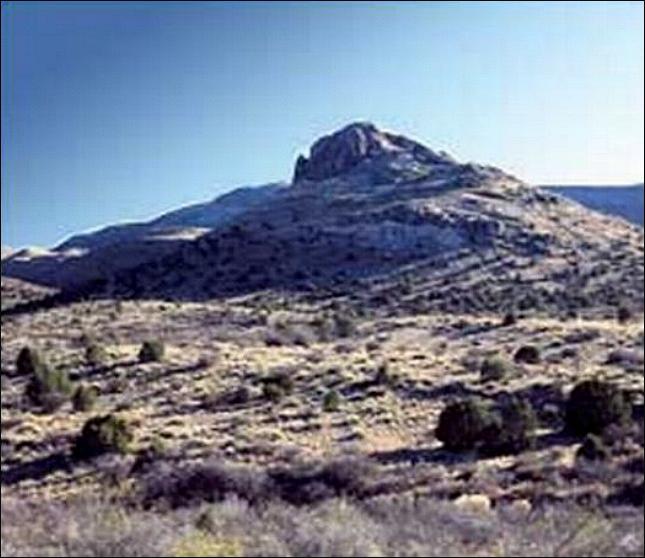New
Mexico is a complex mural with mountains and desert that
dominant the landscape. There are approximately
seventy-three ranges, from Animas to Zuni. They include
seven peaks rising above 13,000 feet, eighty-five more than
two miles high, and more than three hundred notable enough
to warrant names. They're all part of the Southern Rockies,
and abound with strange legends and myths. Aside from UFO's,
the treasure of Victorio Peak is probably the most
notorious. The peak's a
craggy outcropping of
rock barely five hundred feet tall located in the center of
a dry desert lake known as the Hembrillo Basin. Beyond
the Basin is a hundred mile area of desert known as the
Jornada del Muerto, that means Journey of Death,
because during the early Spanish explorations, travelers
took this shortcut through hostile Apache Indian territory.
Many died from Indian attacks, and others from the terrible
desert. Victorio Peak lies within the White Sands Missile
Range in south central New Mexico. Many years ago I saw the
intriguing story about the Peak's hidden treasure on the
television Unsolved Mystery series. Here's
60 Minutes with Dan Rather.
I'd forgotten about it until visiting with friends in
Texas.
Floyd and his friend Pat were getting ready to
look for treasure in an area where Pat found
found three old metal bars in a cave on the old
Spanish trail in New Mexico. They bore the Spanish stamp. He
was overcome with joy that they might be gold. He gave them
to an expert to examine and was told that they were Spanish
brass used for the bells in the missions. Pat was
disappointed. Later he tried to find the bars, but couldn't
locate them. Then he got a call from some explorers who
wanted him to go treasure hunting with them, because they
heard he'd found three gold bars. Later I did some research
and discovered that the Spanish gold bars contained a large
percentage of copper.
It reminded me of the intrigue surrounding the Victoria Peak
mystery.
Long
before Victoria Peak was taken over and surrounded by the
government, a man named Milton Ernest (Doc) Noss took time
exploring Victorio Peak while he was deer hunting. Noss was
born in Oklahoma, but traveled all over the Southwest
seeking adventure. In 1933, he married Ova (Babe)
Beckworth. They made their home in Hot Springs, New Mexico,
which was later became known as Truth or Consequences,
after the popular television game show of the 1950's.
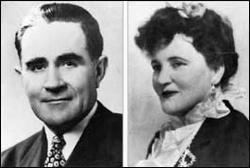
November 1937, Doc, Babe, and four others left on a deer
hunt into the Hembrillo Basin. Setting up camp on the desert
floor at the base of Victorio Peak, the men headed into the
wilderness, while their wives stayed at camp. Hunting
by himself, Doc scouted the base of the mountain. When
it began to rain, Doc sought shelter under a rocky overhang
near the summit of the mountain. While waiting for the
rain to subside he noticed a stone that looked as if it had
been “worked” in some fashion. Reaching down, he was
unable to budge it, but after digging around the rock, he
got his hands under it. Lifting the rock, he found a
hole that lead straight down into the mountain.
Peering into the darkness, Doc saw an old man-made shaft
with a thick, wooden pole attached at one side. Doc thought
that he had discovered an old abandoned mineshaft.
When the rain finally stopped, Doc returned to camp, telling
Babe of the discovery. The two decided to keep the
discovery between themselves and return to the inspect the
shaft later.
Within
just a few days, Doc and Babe were back at the site with
ropes and flashlights. Testing the old wooden pole attached
to one side of the passage, Doc rejected the idea of using
it dropped into the shaft with a rope instead. While
Babe looked on from above, Doc inched his way down the
narrow passageway into the mountain nearly sixty feet.
Near the bottom, he encountered a huge boulder hanging from
the ceiling, almost blocking his way.
Finally reaching the bottom, Doc stepped into a chamber the
size of a small room. On the walls were drawings ,
some painted and others chiseled, that appeared to have been
made by Indians. At one end of the chamber, the shaft
continued downward. Once again, Doc began to descend,
this time about 125 feet before the shaft again leveled off
into a large natural cavern. Several smaller rooms had
been chiseled from the rock along one wall. Stepping
into the eerie darkness, Doc was alarmed when he saw a human
skeleton, kneeling and securely tied to a stake driven into
the ground. The skeleton’s hands were bound behind its
back -- apparently, the person had been deliberately left
there to die. Within moments he found more skeletons,
most of them bound and secured to stakes like the first.
Exploring further he found yet even more skeletons stacked
in a small enclosure, much like a burial chamber. All told,
he reportedly found twenty-seven human skeletons in the
caverns of the mountain.
As Doc continued to explore the
side caverns, he found a hoard of treasure including coins,
jewels, saddles and priceless artifacts including a gold
statue of the Virgin Mary. He also found some old letters,
the most recent of which was dated 1880. This treasure was
only the beginning. In a deeper cavern, Doc found what he
thought was a stack of worthless iron bars. He estimated
there were thousands of these bars, each weighing over forty
pounds stacked against a wall. He was barely able to lift
one, mush less think of carrying it back to the surface.
Later, the wealth in the cave would be calculated to be
worth more than two billion dollars. Doc filled his pockets
with gold coins, grabbed a couple of jeweled swords, and
laboriously returned to Babe waiting anxiously at the
surface. After telling her about what he'd seen and showing
her the loot, she insisted he go back into the mine for one
of the iron bars. After much searching, he found a small
iron bar that he could carry back through the narrow
passageway. When he reached the surface, he told Babe, "This
is the last one of them babies I'm gonna bring out." Babe
rolled the bar over and noticed a yellow gleam where the
gravel of the hillside had scratched off centuries of black
grime. What looked like a piece of iron was actually a solid
gold bar.
After the discovery of the
treasure, Doc and Babe spent every free moment exploring the
tunnels inside the peak, living in a tent at the base of it.
On each trip, Doc would retrieve two gold bars and as many
artifacts as he could carry. At one time, he brought out a
crown, which contained two hundred forty-three diamonds and
one pigeon-blood ruby. Yet, Doc trusted no one, not even
Babe, disappearing into the desert, hiding pieces of the
treasure in places that he never revealed.
Among the artifacts, Doc is
reported to have retrieved were documents dated 1797, which
he buried in the desert in a Wells Fargo chest along with
various other treasures. Although the originals have never
been recovered, a copy of one of the documents was a
translation from Pope Pius III:
 "Seven
is the holy number," the passage begins. It then
continues for several lines before ending with a cryptic
message: "In seven languages, seven signs, and languages
in seven foreign nations, look for the Seven Cities of Gold.
Seventy miles north of El Paso del Norte in the seventh
peak, Soledad, these cities have seven sealed doors, three
sealed toward the rising of the Sol sun, three sealed toward
the setting of the Sol sun, one deep within Casa del Cueva
de Oro, at high noon. Receive health, wealth, and honor.
"Seven
is the holy number," the passage begins. It then
continues for several lines before ending with a cryptic
message: "In seven languages, seven signs, and languages
in seven foreign nations, look for the Seven Cities of Gold.
Seventy miles north of El Paso del Norte in the seventh
peak, Soledad, these cities have seven sealed doors, three
sealed toward the rising of the Sol sun, three sealed toward
the setting of the Sol sun, one deep within Casa del Cueva
de Oro, at high noon. Receive health, wealth, and honor.
Believers think that Doc Noss
found the Casa del Cueva de Oro, Spanish for the House of
the Golden Cave. "Soledad" was the former name of
Victorio Peak, and Doc apparently found the seventh door
located at high noon, but the promised health,
wealth, and honor would evade him. Four years before his
discovery, Congress had passed the Gold Act, which outlawed
the private ownership of gold, so Doc would be unable to
profit from his treasure on the open market. He didn't care
about the historical value of the treasure's inside Victorio
Peak, so he mostly ignored the pouches, packs and artifacts,
while he concentrated on the gold coins and bars. Although
he was unable to sell the gold bars on the open market, Noss
continued to work steadily to remove the treasure.
In the spring of 1938, Doc Noss
and Babe went to Santa Fe to establish legal ownership of
the find, filing a lease with the State of New Mexico for
the entire section of land surrounding Victorio Peak.
Subsequently, he also filed several mining claims on and
around Victorio Peak, as well as a treasure trove claim.
With legal ownership established, Noss began to openly work
the claim, but he also became increasingly paranoid, hiding
the gold bars all over the desert.
When
Doc’s story eventually hit the headlines, scholars began
speculating on how the enormous treasure could have come to
be stashed inside Victorio Peak. Some believe that Doc
Noss found the Casa del Cueva de Oro. Others believe that
Noss found the treasure of Don Juan de Onate, who, in 1598,
founded New Mexico as a Spanish colony.
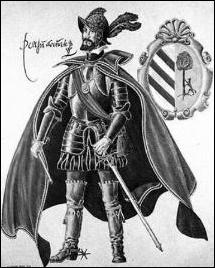 Seeking
out the Seven Cities of Gold, Onate was said to have been a
cruel man, brutally subjugating the Indians to do his
bidding by beating and torturing them. Reportedly, he
amassed a fortune of gold, silver treasure and jewels
before being ordered back to Mexico City in 1607.
Seeking
out the Seven Cities of Gold, Onate was said to have been a
cruel man, brutally subjugating the Indians to do his
bidding by beating and torturing them. Reportedly, he
amassed a fortune of gold, silver treasure and jewels
before being ordered back to Mexico City in 1607.
Others speculate that
the treasure could be the missing wealth of Emperor
Maxmillian, who served as Mexico’s emperor in the
1860’s. When Maxmillian heard of plot to assassinate
him, he began to move his gold and treasures out of
Mexico. Legend says he sent a palace full of valuables
to the United States to be hidden. Maxmillian was
assassinated in 1867.
And then
Chief Victorio enters into the story? The most colorful
legend associated with the Victorio Peak treasure
concerns the great Warm Springs Apache war chief, who
used the entire Hembrillo Basin as his stronghold. He
absolutely refused to live on the San Carlos Reservation
in Arizona where his people died from hunger and insect
bites. Victorio’s land had always been in the mountains
of New Mexico, and a treaty between the Federal
government in Washington and his band had promised they
could stay on those lands as long as the "mountains
stand and the rivers flowed." With the discovery of gold
in the mountains, such did not happen, and in 1878, the
treaty was broken. Victorio went on the war path.
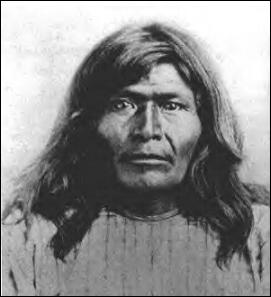
Knowing
how much the white man valued gold and having little use
for it himself, he amassed huge amounts of the yellow
mineral any way he could get it. He and his warriors
raided throughout the Jornada and the Rio Grande Valley,
attacking wagon trains, churches, immigrants, mail
coaches, and anything else that promised riches. He
raided the stage lines all over southern New Mexico and
Texas in an all-out war against the U. S. Army and the
Texas Rangers. He also took prisoners back to the Basin
and subjected them to elaborate torture as a test of
their bravery before killing them.
This could possibly
explain the skeletons in the cavern. It would also
explain the presence of the Wells Fargo bags,
packsaddles, letters and other artifacts dating to
Victorio’s time.
Another theory
is that the treasure belonged to a Catholic missionary named
Felipe La Rue, or La Ruz, as church documents are said to
give his name. He was a native of France and was among the
small group of priests who volunteered for service in
Mexico. His party sailed to Florida, crossed the Gulf of
Mexico to Vera Cruz, and from there, it went to Mexico City
by ox cart. After a short rest, Padre La Rue left for the
north, where he took up his work among the Indians and peons
at a large hacienda near what is now the city of Chihuahua,
reaching there in 1798. From the people at his new station,
he heard stories about a fabulous source of rich minerals in
the mountains to the north. If he was interested in these
stories, he did not reveal it. Instead, he continued with
his teachings and ministering to the sick and spiritual
needs of his small parish. Among his parishioners was an old
man, who had been an explorer and soldier of fortune during
his youth. This man had traveled widely over the country to
the north, and as Padre La Rue personally cared for this
ailing old man, the two became good friends.
One day, Padre
La Rue asked about the riches which lay to the north. The
old man said that if the good priest wanted gold, there was
a rich deposit of it located high in the mountains about two
days’ travel north of El Paso del Norte, which is the
present-day site of El Paso, Texas. According to the legend,
the man said, "After one day’s travel from El Paso del
Norte, you will come to three small peaks yet further to the
north. Upon first sight of these peaks, turn to the east and
cross the desert toward the mountains. In the mountains, you
will find a basin where there is a spring at the foot of a
solitary peak. On this peak, you will find gold." A few days
later, the old man died. It was not until the crops failed
that Padre La Rue thought of the solitary peak filled with
gold. His little parish needed water and a better climate,
and he called everyone together, asking if they would follow
him north. They all agreed, and the little party set out for
their new country. After crossing El Paso del Norte, they
followed the course of the Rio Grande to the small village
of La Mesilla near Las Cruces. North of there, they sighted
the three peaks and turned east across the dreaded Jornada
del Muerto, finally arriving in the San Andreas Mountains.
After a couple of days of exploration, they located a basin
in which there was a spring at the base of a solitary peak,
just as the old man had said. Scholars all believe this
basin was the Hembrillo Basin, and the solitary peak was
Soledad Peak. After a fierce battle between the Army and
Chief Victorio of the Apaches in 1880, the peak assumed a
new name of Victorio Peak. It is not to be confused with
Victoria Peak in the Black Range Mountains near Kingston,
New Mexico.
Padre La
Rue established a crude camp and sent the men out to
search for the gold the old man had promised was there.
On one side of the peak, they located a rich vein,
ultimately working the mine for years. They tunneled
into the mountain and followed the vein downward. The
deeper they went, the richer the ore became. The little
priest assigned dozens of monks and Indians to mine the
gold, form it into ingots and, except for whatever was
needed for supplies, stack it along one wall of a
natural cavern inside the mountain. Word eventually
reached church officials in Mexico City that the
hacienda had been abandoned, and Padre La Rue’s tiny
colony was missing. A search party went to investigate.
When they returned and reported that the entire
population had left for the mountains to the north,
soldiers were dispatched with orders to locate the
priest and demand an explanation. It was when a small
group was in La Mesilla purchasing supplies that they
learned the Mexican Army was on the horizon. Hurrying to
camp, they spread the alarm. It was one thing for Padre
La Rue to leave his post without permission of church
officials in Mexico City, but it was quite another not
to deliver the Royal Fifth (or Quinta) of the gold for
shipment to Spain. Padre La Rue was in a lot of trouble.
Padre La Rue immediately set about concealing all traces
of the mine. Working day and night, knowing the soldiers
were drawing ever closer, he had his little group labor
to conceal the entrance. When the soldiers finally
arrived and demanded to know where the gold came from
which was used to purchase the supplies in La Mesilla,
Padre La Rue refused to answer. He died under torture,
as did many of his followers, and although the soldiers
looked all over for evidence of a mine, they were forced
to return to Mexico City with nothing to show for their
long journey. The Lost Padre Mine, as it has been called
ever since, went into the history pages as a beloved
legend.
Meanwhile...In the Fall of 1939,
Doc wanted to enlarge the passageway into Victorio Peak so
that the treasures could be more easily removed.
Hiring a mining engineer by the name of S.E. Montgomery, the
two went into the mountain to blast out the shaft.
The engineer suggested eight sticks of dynamite, to which
Noss heatedly disagreed, claiming the mountain was too
unstable. The “expert” won the argument.
However, the blast was a disaster, causing a cave-in,
collapsing the fragile shafts, and effectively shutting Doc
out of his own mine. Doc tried several times to regain entry
into his mine, but the shaft was sealed with tons of debris.
All attempts failed, leaving him an embittered and angry
man, which caused problems in his marriage. Noss soon
deserted Babe and in November 1945, a divorce was granted.
Two years later, he married Violet Lena Boles, which would
further complicate ownership of the treasure rights for
years to come.
Now,
instead of having thousands of gold bars to draw from, Noss
had only a few hundred that he had hidden in the desert.
Becoming desperate for cash, Doc along with another man
allegedly transported gold bars, coins, jewels, and
artifacts into Arizona, selling them on the black market.
For nine years, Doc attempted to sell his gold, but it
was difficult finding buyers.
In 1948, Doc met
Charles Ryan, a Texan involved in drilling operations and
oil exploration in West Texas. Noss made an agreement
with Ryan to exchange some of the gold bars for $25,000 to
reopen the shaft. Meanwhile, Babe Noss had filed a
counter-claim on the entire area. Denied entry by the courts
until legalities could determine the legal owner of the
mine, Doc feared Ryan would back out of the deal. Sensing a
double-cross by Ryan, Doc dug up the gold that was to be
used in the exchange and reburied it in place where Ryan was
unaware.
The next day, March 5, 1949, Ryan arrived to the area,
insisting that they discuss the problem of what happened to
the gold. However, Noss demanded to see the money
before revealing the new hiding place. Ryan hinted
that if Noss did not reveal the whereabouts of the gold, Doc
would not live to enjoy it. An intense argument ensued and
Noss headed toward his car. Ryan, fearing Doc was
getting a gun, fired a warning shot in Doc’s direction,
demanding that Noss back away from the vehicle. Noss
refused to obey and Ryan fired again, hitting Noss in the
head, killing him instantly. Just twelve years after
discovering the treasure, Doc Noss died with just
$2.16 in his pocket. Ryan was charged with murder, but was
later acquitted.
As the years passed
Babe Noss held onto her claim at Victorio Peak, occasionally
hiring men to help her clear the shaft. However, it was a
slow process and in 1955, the White Sands Missile Range
unexpectedly
expanded their operations to encompass the
Hembrillo Basin. Babe began a regular correspondence
with the military requesting permission to work her claim,
but she was always denied. From that moment onward,
every attempt of Babe’s to clear the rubble from the plugged
shaft met with a military escort out of the area.
This was the beginning
of long legal battles over the ownership of the claim.
The military claim stemmed from a statement made by New
Mexico officials on November 14, 1951 which withdrew
prospecting, entry, location and purchase under the mining
laws, reserving the land for military use only.
However, disputing the military claim, New Mexico officials
stated that they leased only the surface of the land to the
military. Further, they stated that underground
wealth, in whatever form it took, belonged to the state or
to any legal license holders.
Becoming even more
complicated, a search of mining records failed to turn up
any existing claims including that of Doc
Noss. Additionally, the actual land where Victorio Peak is
located was not owned by the State of New Mexico, but
rather, by a man named Roy Henderson who had leased it to
the Army.
The
dispute was finally worked out when a federal court issued a
compromise of sorts, which stated the Army would continue to
use the surface of the land, but no one would be allowed on
the property without the Army’s consent. In effect, no one
could mine the treasure, and that included the Army and Babe
Noss.
Even though the military refused any of Babe’s efforts to
work her claim, it apparently did not refuse other military
personnel from exploring portions of Victorio Peak.
Two airmen from nearby Holloman Air Force Base would later
say that they had found the gold cavern from another natural
opening in the side of the peak. The soldiers, Airman
First Class Thomas Berlett and Captain Leonard V. Fiege,
said they had found approximately one hundred gold bars
weighing between forty and eighty pounds each in a small
cavern. After the discovery, Fiege told several people
that he had caved in the roof and walls to make it look as
if the tunnel ended.
Neither man being familiar with laws governing the discovery
of treasure on a military base, Fiege went to the Judge
Advocate’s Office at Holloman Air Force Base to confer with
Colonel Sigmund I. Gasiewicz. Now there were two
military commands involved.
Berlett and Fiege formed a corporation to protect what they
had found, as well as making a formal application to enter
White Sands for a search and retrieval of the gold. However,
White Sands issued an edict expressly forbidding them to
return to the base. In the summer of 1961, upon the advice
of the Director of the Mint, Major General John Shinkle of
White Sands allowed Captain Fiege, Captain Orby Swanner,
Major Kelly and Colonel Gorman to work the claim. On August
5, Fiege and his party returned to Victorio Peak,
accompanied by the commander of the Missile Range, a secret
service agent, and fourteen military police. Try as he
would, Captain Fiege was unable to penetrate the opening he
had used just three years earlier. General Shinkle finally
had enough and ordered everyone out. Later, Fiege would take
a lie detector test, which would allow Fiege back on the
missile range. This time, the military began a full-scale
mining operation at the Peak.
Fueled by suspicions that the military was working her
claim, Babe Noss hired four men to surreptitiously enter the
range. Though caught trespassing and escorted from the
area, the men reported that they had observed several men in
Army fatigues upon the peak. An affidavit dated
October 28, 1961, was signed to this effect, also claiming
to have seen a military jeep and a weapons carrier on the
mountain. Immediately reporting the activity to Babe
Noss, Babe contacted Oscar Jordan with the New Mexico State
Land Office, who in turn, contacted the Judge Advocate’s
Office at White Sands. In December 1961, General
Shinkle shut down the operation and excluded anyone from
entering the base who was not directly engaged in the
missile research activities.
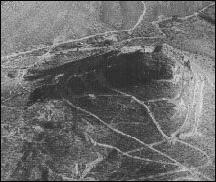
In 1963, the Gaddis
Mining Company of Denver, Colorado, under a contract with
the Denver Mint and the Museum of New Mexico, obtained
permission to work the site. For three months
beginning on June 20, 1963, the group used a variety of
techniques to search the area; however, they failed to turn
up anything. Left is an aerial view of Victorio Peak looking
north. The roads are the result of the search.
In 1972, F. Lee
Bailey, became involved in the dispute, representing some
fifty clients including Babe Noss, the Fiege group, Violet
Noss Yancy, Expeditions Unlimited (a Florida based treasure
hunting group), and many others. Reaching a compromise
the military based allowed Expeditions Unlimited,
representing all of the claimants to excavate the peak in
1977. However, the Army placed a two-week time limit
on the group and they had hardly started before they were
forced to leave, without finding anything. The Army
then shut down all operations stating that no additional
searches would be allowed.
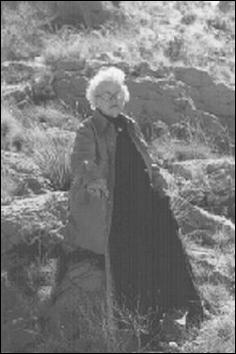
In 1979, Babe died
without ever finding the treasure. However, Terry
Delonas, her grandson, continued the family tradition and
formed the Ova Noss Family Partnership. By this time,
Babe’s story had spread across the nation, profiled in
several magazines and newspapers. Hearing about the
story, a man by the name of Captain Swanner, who was
stationed at White Sands Missile Range in the early 1960’s
came forward. Speaking to a Noss family member, he stated
that he had been the Chief of Security in 1961 and was sent
to inspect the report made by Airman Berlett and Captain
Fierge. After determining the accuracy of the two
men’s reports, the entire area was placed off-limits until
an official investigation could be conducted. Reportedly the
military was able to penetrate one of the caves and
inventory the contents. The gold was supposedly
removed from the cave and sent to Fort Knox. Though
the military confirmed that Swanner had served at White
Sands during this time, they claimed there were no documents
to support an investigation into the mine nor the removal of
the gold bars.
Today, Army’s official position on the whereabouts of the
gold is remains cautious, maintaining that the burden of
proof rests with the accusers. Many members of the Noss
family and friends believe that the military exploited
Babe’s claim and that the treasure is now gone. However,
Terry Delongas stated, "We're not accusing the military of
stealing the gold, but I do feel that the Department of the
Army in the 1960’s treated my grandmother unfairly.....
However, we’ve worked very hard over the years to establish
a working relationship with the military, and we're
certainly not going to jeopardize that by accusing them of
theft." The whole truth will probably never be known, but
there is no doubt that a treasure existed. Too much
evidence supports the treasure including photographs,
affidavits and relics still held by the Noss family.
In
a special act of Congress passed in 1989, the Hembrillo
Basin was “unlocked” for Terry Delonas and the Noss heirs;
however nothing has been found.
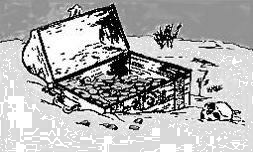
Epilogue
On January 10, 2010 Author Barbara
Marriott emailed me that she is writing a book on New
Mexico that will include a chapter about the Noss's and
Victorio Peak. She has written several books that look
very interesting.
www.barbaramarriott.com
October
11, 2012 Becca Gross (of
Prometheus Entertainment) emailed me that she's
currently working on a documentary series for the
History Channel, and wanted to check in
regarding the
possibility of an on-camera interview. In the second
season of "America's Book of Secrets," they reveal
lesser-known information behind some of America's most
mysterious organizations. In the episode she's currently
researching, they're looking at some of America's lost
treasures, including Victorio Peak. She thought my
knowledge might be a great contribution.
I told her that everything I know was gleaned from others,
so don't know what more to add, other than what
impressed me about the entire story. The ancient legend
is fascinating, along with the
disappearance of the treasure from the mountain while
being controlled by the government military base.
It's a never ending story of what
happens to the mentality of those possessed by greed
and fear.
I'll be looking forward to watching
this new documentary on "America's
Book of Secrets" when, and if it's completed.
